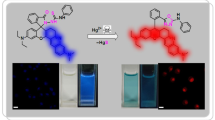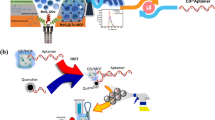Abstract
SO2 and its derivatives are widely present in the environment and living organisms, endangering the environment and human health. Therefore, it is of great significance for the effective detection of sulfur dioxide (SO2) and its hydrated derivatives (HSO3− /SO32−). In this study, based on the mechanism of intramolecular charge transfer (ICT), a water-soluble colorimetric fluorescent probe (E)-2-(4-acetamidostyryl)-3-(5-carboxypentyl)-1, 1-dimethyl-1H-benzo[e]indol-3-ium (ABI) for the detection of SO2 derivatives was successfully synthesized from p-acetaminobenzaldehyde by connecting the benzo[e]indoles cationic fluorophore containing highly activated methyl via C = C double bond, and the ABI structure was characterized by HRMS and 1H NMR, 13 C NMR. Studies have shown that the ABI probe has some advantages such as good selectivity for SO2 derivatives, high sensitivity (detection limit LOD = 14.9 nM), and fast reaction rate. After adding HSO3−, the color of the probe solution changed from light yellow to colorless within 10 s, which provides a simple way to identify bisulfite with the naked eye. Studies on the effect of pH on the fluorescence performance of ABI showed that fluorescence performance of ABI was stable in the range of pH (7.0-10.26). Therefore, ABI is expected to become an effective tool for detecting SO2 derivatives in cells and organisms in the future.
Graphical Abstract







Similar content being viewed by others

Data Availability
All data generated or analysed during this study are included in this published article [and its supplementary information files].
References
Fazio T, Warner CR (1990) A review of sulphites in foods: Analytical methodology and reported findings. Food Addit Contam 7:433–454. https://doi.org/10.1080/02652039009373907
Lisanti MT, Blaiotta G, Nioi C, Moio L (2019) Alternative methods to SO2 for microbiological stabilization of wine. Compr Rev Food Sci Food Saf 18:455–479. https://doi.org/10.1111/1541-4337.12422
Ba-Shammakh MS (2011) A multiperiod mathematical model for integrating planning and SO2 mitigation in the power generation sector. Energy Fuels 25:1504–1509. https://doi.org/10.1021/ef101569q
Mapoma HWT, Tenthani C, Tsakama M, Kosamu IBM (2014) Air quality assessment of carbon monoxide, nitrogen dioxide and sulfur dioxide levels in Blantyre, Malawi: A statistical approach to a stationary environmental monitoring station. Afr J Environ Sci Technol 8:330–343. https://doi.org/10.5897/AJEST2014.1696
Menz FC, Seip HM (2004) Acid rain in Europe and the United States: an update. Environ Sci Policy 7:253–265. https://doi.org/10.1016/j.envsci.2004.05.005
Yue S, Li Y, Ma X, Duan L (2016) An A-π-A’structural ratiometric flfluorescent probe based on benzo[e]indolium for bisulfifite and its application in sugar samples and living cells. RSC Adv 6:79830–79835. https://doi.org/10.1039/C6RA15605C
Xu J, Pan J, Jiang X, Qin C, Zeng L, Zhang H, Zhang J (2016) A mitochondria-targeted ratiometric fluorescent probe for rapid, sensitive and specific detection of biological SO2 derivatives in living cells. Biosens Bioelectron 77:725–732. https://doi.org/10.1016/j.bios.2015.10.049
Sun Y, Liu J, Zhang J, Yang T, Guo W (2013) Fluorescent probe for biological gas SO2 derivatives bisulfite and sulfite. Chem Commun 49:2637–2639. https://doi.org/10.1039/C3CC39161B
Zhao C, Shang JY, Yang C, Li Z, Ning J, Li HP (2020) A water-soluble fluorescent probe for rapid detection of sulfur dioxide derivatives. Anal Sci 36:329–333. https://doi.org/10.2116/analsci.19P314
Xiao H, Xin K, Dou H, Yin G, Quan Y, Wang R (2015) A fast-responsive mitochondria-targeted fluorescent probe detecting endogenous hypochlorite in living RAW 264.7 cells and nude mouse. Chem Commun 51:1442–1445. https://doi.org/10.1039/C4CC07411D
Hou P, Chen S, Voitchovsky K, Song X (2015) A colorimetric and ratiometric fluorescent probe for sulfite based on an intramolecular cleavage mechanism. Luminescence 29:749–753. https://doi.org/10.1002/bio.2616
He L, Yang X, Liu Y, Kong X, Lin W (2016) A ratiometric fluorescent formaldehyde probe for bioimaging applications. Chem Commun 52:4029–4032. https://doi.org/10.1039/C5CC09796G
Ding S, Feng G (2016) Smart probe for rapid and simultaneous detection and discrimination of hydrogen sulfide, cysteine/homocysteine, and glutathione. Sens Actuators B Chem 235:691–697. https://doi.org/10.1016/j.snb.2016.05.146
Sun Q, Zhang W, Qian J (2017) A ratiometric fluorescence probe for selective detection of sulfite and its application in realistic samples. Talanta 162:107–113. https://doi.org/10.1016/j.talanta.2016.10.002
Cappiello M, Corso AD, Camici M, Mura U (1993) Thiol and disulfide determination by free zone capillar electrophoresis. J Biochem Biophys Methods 26:335–341. https://doi.org/10.1016/0165-022X(93)90034-L
Koch M, Köppen R, Siegel D, Witt A, Nehls I (2010) Determination of total sulfite in wine by ion chromatography after in-sample oxidation. J Agric Food Chem 58:9463–9467. https://doi.org/10.1021/jf102086x
Zhong Z, Li G, Zhu B, Luo Z, Huang L, Wu X (2012) A rapid distillation method coupled with ion chromatography for the determination of total sulphur dioxide in foods. Food Chem 131:1044–1050. https://doi.org/10.1016/j.foodchem.2011.09.086
Zheng J, Tan F, Hartman R (2015) Simple spectrophotometry method for the determination of sulfur dioxide in an alcohol-thionyl chloride reaction. Anal Chim Acta 891:255–260. https://doi.org/10.1016/j.aca.2015.05.043
Claudia R, Francisco J (2009) Application of flow injection analysis for determining sulphites in food and beverages: A review. Food Chem 112:487–493. https://doi.org/10.1016/j.foodchem.2008.05.085
Casella IG, Guascito MR, Desimoni E (2000) Sulfide measurements by flow injection analysis and ion chromatography with electrochemical detection. Anal Chim Acta 409:27–34. https://doi.org/10.1016/S0003-2670(99)00769-2
Ekkad N, Huber C (1996) A coulometer for determination of residual sulfite following the dechlorination of water. Anal Chim Acta 332:155–160. https://doi.org/10.1016/0003-2670(96)00156-0
Isaac A, Livingstone C, Wain A, Compton R, Davis J (2006) Electroanalytical methods for the determination of sulfite in food and beverages. TrAC Trends Anal Chem 25:589–598. https://doi.org/10.1016/j.trac.2006.04.001
Lu J, Niu L, Yang Q (2020) Fluorescent probe for simultaneous discrimination of GSH, Cys, and SO2 derivatives. Anal Chem 92:10800–10806. https://doi.org/10.1021/acs.analchem.0c02255
Sun W, Li N, Li Z, Yuan Y, Miao J, Zhao B, Lin Z (2020) A mitochondria-targeted ratiometric fluorescence probe for detection of SO2 derivatives in living cells. Dyes Pigments 182:108658. https://doi.org/10.1016/j.dyepig.2020.108658
Wang L, Zhao L, Xu Z, Ma Y, Wang X, Sun Q, Liu H (2020) Rapid detection of SO2 in living cells and zebrafish by using an efficient near-infrared ratiometric fluorescent probe with large emission shift. Microchem J 160:105703. https://doi.org/10.1016/j.microc.2020.105703
Li J, Li X, Jia J, Chen X, Lv Y, Guo Y, Li J (2019) A ratiometric near-infrared fluorescence strategy based on spiropyran in situ switching for tracking dynamic changes of live-cell lysosomal pH. Dyes Pigments 166:433–442. https://doi.org/10.1016/j.dyepig.2019.03.060
Zhang LJ, Wang ZY, Liu JT, Miao JY, Zhao BX (2017) A rational design of ratiometric fluorescent probes based on new ICT/FRET platform and imaging of endogenous sulfite in living cells. Sens Actuators B Chem 253:19–26. https://doi.org/10.1016/j.snb.2017.06.072
Wan Q, Chen S, Shi W, Li L, Ma H (2014) Lysosomal pH rise during heat shock monitored by a lysosome-targeting near‐infrared ratiometric fluorescent probe. Angew Chem Int Ed 53:1–6. https://doi.org/10.1002/ange.201405742
Li Z, He X, Wang Z, Yang R, Shi W, Ma H (2015) In vivo imaging and detection of nitroreductase in zebrafish by a new near-infrared fluorescence off–on probe. Biosens Bioelectron 63:112–116. https://doi.org/10.1016/j.bios.2014.07.024
Mishra A, Behera R, Behera P, Behera P, Behera G (2000) Cyanines during the 1990s: A review. Chem Rev 100:1973–2011. https://doi.org/10.1021/cr990402t
Zhao X, Yin G, Jin D, Yan X, Li Y, Chen L (2015) A sensitive colorimetric and ratiometric chemosensor for trivalent metal cations. J Fluoresc 25:327–333. https://doi.org/10.1007/s10895-015-1513-5
Jin D, Zhao X, Li Y, Yan X, Chen L (2016) A novel near-infrared colorimetric probe for fluoride anions based on a heptamethine dye. Anal Methods 8:6452–6457. https://doi.org/10.1039/C6AY01312K
Ye Z, Duan C, Sheng R, Xua J, Wang H, Zeng L (2018) A novel colorimetric and ratiometric fluorescent probe for visualizing SO2 derivatives in environment and living cells. Talanta 176:389–396. https://doi.org/10.1016/j.talanta.2017.08.054
Liu Y, Li K, Xie K, Li L, Yu K, Wang X, Yu X (2016) A water-soluble and fast-response mitochondria-targeted fluorescent probe for colorimetric and ratiometric sensing of endogenously generated SO2 derivatives in living cells. Chem Commun 52:3430–3433. https://doi.org/10.1039/C5CC10505F
Liu Y, Li K, Wu M, Liu Y, Xie Y, Yu X (2015) A mitochondria-targeted colorimetric and ratiometric fluorescent probe for biological SO2 derivatives in living cells. Chem Commun 51:10236–10239. https://doi.org/10.1039/C5CC03055B
Acknowledgements
This study was supported by the Open Fund of Key Laboratory of Road Structure and Material of Ministry of Transport (kfj170301), Hunan Provincial Natural Science Foundation of China (2019JJ40295), Changsha University of Science and Technology Postgraduate Research and Innovation Project (CX2019SS31) and Key Project of Hunan Provincial Education Department of China (17A002).
Author information
Authors and Affiliations
Contributions
Jinyan Shang is involved in synthesis and performance analysis, and Yanbo Li, Kangni Chen and Heping Li are involved in performance testing. The first draft of the manuscript was written by Jinyan Shang and all authors read and approved the final manuscript.
Corresponding author
Ethics declarations
Conflicts of Interest
The authors declare no conflicts of interest.
Additional information
Publisher’s Note
Springer Nature remains neutral with regard to jurisdictional claims in published maps and institutional affiliations.
Supplementary Information
ESM 1
(DOCX 513 kb)
Rights and permissions
About this article
Cite this article
Shang, J., Li, Y., Chen, K. et al. Synthesis and Properties of a Water‐soluble Fluorescent Probe Based on ICT System for Detection of Ultra‐trace SO2 Derivatives. J Fluoresc 31, 755–761 (2021). https://doi.org/10.1007/s10895-021-02702-7
Received:
Accepted:
Published:
Issue Date:
DOI: https://doi.org/10.1007/s10895-021-02702-7



